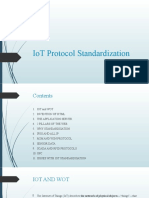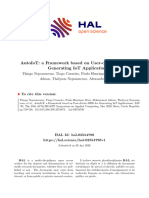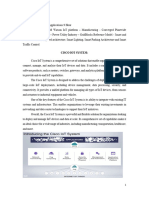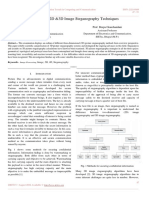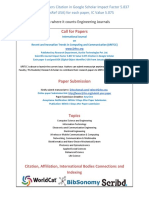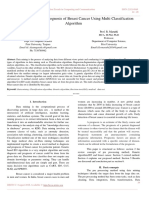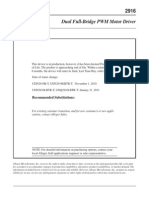Developement of Horizontal IoT Platform Using DeviceHive Framework
Uploaded by
Editor IJRITCCDevelopement of Horizontal IoT Platform Using DeviceHive Framework
Uploaded by
Editor IJRITCCInternational Journal on Recent and Innovation Trends in Computing and Communication
Volume: 3 Issue: 5
ISSN: 2321-8169
2574 - 2578
_______________________________________________________________________________________________
Developement of Horizontal IoT Platform using DeviceHive Framework
Thakor Jay Chandrasinh
VLSI & Embedded System Design
GTU PG School
Ahmedabad, India
thakor.jay@gmail.com
Mr. Chaitannya Mahatme
Zeroes & Ones Technologies.
Pune,India
info@znotech.com
AbstractThis paper presents the Horizontal IoT(Internet of Things) Platform for IoT application development. This paper
mainly describes the limitations of Vertical Approach for different domain applications and also presents generalized solution for
limitations as Horizontal IoT Platform. In the context of IoT/M2M domain, devices perform the automated tasks data sensing,
generation, logging and reporting to service. For this, a generic solution unifying the infrastructure and platforms that access and
control different Vertical Domains leads to the Horizontal Platform. An Open Source DeviceHive Framework is used for
developing this generic solution for building different IoT application.
KeywordsHorizontal IoT Platform, M2M, DeviceHive Framework, Gateway.
__________________________________________________*****_________________________________________________
architecture for a generic solution. A paradigm shift in
I.
INTRODUCTION
M2M/IoT space from Vertical to Horizontal domains is being
speculated for this purpose. There is very thin line between
IoT is revolution in Internet Technology. IoT is the
M2M and IoT as in every device will have specific IP address
emerging technology and is very important one in next few
which makes them to communicate directly with server where
years. As a global prediction by 2020, 50 billion objects are
as in M2M localized devices communicate with and aggregator
connected over the internet and communicating smartly over
device called as Gateway which in turn communicates with
it[1]. IoT in its culmination, where we lived in data is defined
server over IP protocol. In recent years several standardization
as:" The IoT creates an intelligent, invisible network fabric that
activities towards a horizontal service layer approach have been
can be sensed, controlled and programmed. IoT-enabled
started by standardization organizations (SDO) world-wide.
products employ embedded technology that allows them to
Here the activities at TIA in the TIA-50[5] group (M2M Smart
communicate, directly or indirectly, with each other or the
Device Communication) in the USA, CCSA TC10 in China
Internet.[2]" Now using this connected devices called as
and the activities in the ETSI TC M2M[6] group in Europe
Wireless Sensor Networks many applications are developed in
should be explicitly mentioned.
various domains, like Smart Home, Smart Health, Smart
Shopping and Smart Transportation to improve life. But the
ONEM2M[7] is other example of the M2M communication
main problem of the application is the interoperability of
Framework. An open world-wide M2M service layer standard,
various wireless protocol over which the sensor devices
based on the future ONEM2M standard, will open up the
communicate. Such applications are built using the Vertical
possibility for a broad range of companies and players to enter
approach, so they can't be easily shifted in any other domain.
the market with different sets of possible business models.
Such problem of interoperability is main concern of the
recent development of IoT application. Which requires
standardized "Protocol Layer" using which any device or
protocol can communicate smoothly. Such a Protocol Layer is
called "Service Capability Layer" between Transport Layer and
Application Layer which is the main objective of this paper.
Here, as discussed the "Service Capability Layer"(SCL) is
the key enabler for the Horizontal IoT Platform. This will help
to develop generic solution for the IoT application across
domains. For devices to communicate smartly with each other
,SCL requires certain features are: i) technologies that enable
things to acquire contextual information,(Data Sensing and
Acquisition) ii) technologies that enable things to process
contextual information,(Data Analytics) and iii) technologies to
improve security and privacy(Data Security).
II.
IOT DOMAINS:FROM VERTICAL TOWARDS HORIZONTAL
Recently IoT applications are used in different domains as
per the specific environment and needs. For this application up
till now the available models are i.e., FP7 projects IoT-I [3] and
IoT-A [4]. But these models specifically used for the vertical
approach only. There is no availability of any standardized
model for Horizontal approach. Since IoT is being percolated
in every vertical there is to unify the infrastructure and
A. M2M Standardization
As vertical proprietary M2M solutions provides some value
to their vertical sectors, most challenges are identified in
scalability and interoperability[8].Thus standardization of
M2M communication is done by surveying different vertical
domains and collect common ontology from it moving to a
proper horizontal solution. As shown in figure 1 the industries
are moving from Vertical towards Horizontal[9].
As shown in Figure 1 Specific algorithm is used for a
business application in vertical domain whereas a standard
protocol layer i.e., "Service Capability Layer", shown as
Common Application Infrastructure is being used to build the
application across verticals, This "Common Application
Infrastructure" is transforming underlying framework from
Vertical to Horizontal platform. There are many different
business applications as well as many devices are connected to
local network or gateways using different protocols. Mostly
Restful APIs are used for development of this kind of Protocol
Layer. As shown in Figure 1 the layer is not bounded between
Application and Transport Layer. But it's some functionality is
laid in between gateways and devices. So the Services given by
the common layer is distributed in all the components of
proposed architecture.
2574
IJRITCC | May 2015, Available @ http://www.ijritcc.org
_______________________________________________________________________________________
International Journal on Recent and Innovation Trends in Computing and Communication
Volume: 3 Issue: 5
ISSN: 2321-8169
2574 - 2578
_______________________________________________________________________________________________
proposed architecture. Most of the services of common layer
are provided in Gateway only and others are implemented on
the device as well as on server side.
The comparative study is conducted among the available
OneM2M standards and device hive as SCL module.
Table 1 Comparison between ONEM2M and DeviceHive Standards
Figure 1 Moving From Vertical Towards Horizontal (Source:ONEM2M)
B. ETSI TC M2M Architecture
International standard developing organizations, such as
the European Telecommunication Standard Institute (ETSI)
have set their effort in the definition of a standard for a high
level service layer platform for M2M. For the elaboration of
such a standard, ETSI collected requirements from several
important vertical markets of IoT/M2M. ETSI TC M2M was
created in January 2009 in order to standardize specifications
for developing and maintaining an end-to-end architecture for
M2M systems. ETSI TC M2M has standardized various
common features such as device management, discovery,
security, location, etc. These common features can be used in
various verticals. Such as Connected Vehicle, Smart Metering
and e-Health.
As shown in Figure 2 the ETSI TC M2M Architecture has
three different domains namely: i) Application ii) Network and
iii) Device. The Network Domain comprises a collection of
service capabilities in addition to core and access networks.
The Device Domain contains sensors, actuators and other
devices typically found in a wireless sensor network. ETSI
also defines an M2M Gateway which also holds services that
cannot be directly used by low level tiny devices like
microcontroller. The Application Domain includes M2M
Applications and Client Applications.
Functional Entity
M2M Service Capability
hosted in the network
domain
M2M Service Capability
hosted
on
an
intermediary node
M2M Service Capability
hosted on an M2M
Device
ETSI M2M
Yes, Network Service
DeviceHive
Yes
Capability Layer (NSCL)
Device Hive API
Yes, Gateway Service
Yes
Capability Layer (GSCL)
Gateway
Yes, Device Service
Yes
Capability Layer (DSCL)
Device Base Class
Applications in
network domain
the
Yes,
Device Host Class
Yes
Applications
M2M Device
the
M2M Device
AAA Server
in
Network Applications (NA)
Yes,
Application Layer
Client App.
Yes
Device Application (DA)
Yes, Device with/without
Yes
Service Capabilities (D/D')
Device with OS
Yes, M2M Authentication
Device w/o OS
Two type of
Server (MAS), M2M
Authentication.
Service Bootstrap function
i)Device
(MSBF)
ii)User(HTTP)
A. Hardware Model
The model mainly consist the following components as
show in Figure 3.
Figure 3 Proposed Architecture
Figure 2 ETSI TC M2M Architecture (Source: ETSI)
III.
PROPOSED SYSTEM ARCHITECTURE
The proposed system is divided into Hardware and
Software Models. Figure 3 shows hardware components used
in proposed system architecture. Here the Gateway is the most
important component of the architecture. Raspberry Pi B+
module is being used as a gateway. And it works as the
middleware between the devices/nodes and Server It is similar
to ETSI M2M model. But here we are using Device Hive
Framework for building the Service Capability Layer in the
System Architecture Components:(i) Different nodes (sensors, actuators, etc.)
(ii) Gateway(H/W:Raspberry pi b+, S/W:Device Hive
Framework)
(iii) Server (Device Hive API)
(iv) Client Application (PC)
Here we are developing a generic solution so the device
nodes can be of any vertical domains for instance Home
Automation has different sensors like temperature, PIR,
2575
IJRITCC | May 2015, Available @ http://www.ijritcc.org
_______________________________________________________________________________________
International Journal on Recent and Innovation Trends in Computing and Communication
Volume: 3 Issue: 5
ISSN: 2321-8169
2574 - 2578
_______________________________________________________________________________________________
pressure, etc. In case of Smart Transport it could be any GPS
module. A server for the proposed architecture is designed as
mentioned in DeviceHive Framework[10] which has web based
interface.
B. Software Model
Device Hive Framework is used as a software framework
for building the IoT Horizontal Platform on a Gateway i.e.,
Raspberry Pi B+. Device Hive is a C++ based Framework
skeleton used for building software to the Hardware Model.
The most important part of software is Gateway Configuration
and Device(Gateway, Sensors) Registration with server
seamless connection between the Server and Devices. for data
communication. For this the flow diagram is shown Figure 4.
2) Restfull Protocol:The DeviceHive API (Restful API) is the central part
of the framework which allows different components
to interact with each other. The API provides access
to information about registered components in the
system, and allows them to exchange messages in real
time. Three types of users are there which are using
the DeviceHive API as shown in below Figure 5.
We are using two types of protocols for communication
among system components.
1) Binary Protocol:The DeviceHive Binary Protocol is used for
transferring messages between various low-level
devices and the gateway. In the DeviceHive
architecture, the gateway acts as a proxy between
devices and the DeviceHive cloud and converts
binary messages to REST API service calls and vice
versa. Devices connected to the gateway are
considered to be very simple equipment which do not
implement TCP/IP stack on their own and have no
direct access to the Internet. To route messages
from/to the cloud, these devices connect to the
gateway using various wired as well as wireless
interfaces such as RS-232,RS-485, SPI or ZigBee,
and use the Binary Protocol to communicate about
various events in the system.
Figure 5 DeviceHive API use cases (Source:DeviceHive)
C. Modules of Implementation
Study the Device Hive Framework for the
Implementation of the proposed Solution.
-
Building of Boost Libraries[11] . Which mainly
contains boost.asio , boost.smart_ptr , boost.bind
Build the boost for Linux using the Cross
Compile Toolchain build+ using crosstool-ng
tool.
Gateway Compilation and Configuration
Connection of Gateway to Server as well as
Devices Connected to it.
Implement the common service provided by
Service Layer Capabilities.
IV.
Figure 4 Flow Diagram
COMPLITION OF COMMUNICATION LINK
The flow starts with the initialization of the gateway as
shown in the figure 4. The gateway is Raspberry Pi B+
module. The device hive framework is used for the
initialization and connection to the server as well as devices.
First of all the gateway is activated. For this the gateway must
be configured as per the requirement. For gateway
configuration some command line arguments have to be
passed such as --serial port --server server link --no ws. After
the gateway is configured and made up & running, it polls the
device if it connected to it or not. If the device is connected to
it then it send request to the device to register itself. If the
device didn't respond to request before timeout expired ,then
the gateway is connected to server and gets the server
information. On getting information of the server the gateway
again send request to device for registration. In the registration
request the following bit stream is passed from gateway.
2576
IJRITCC | May 2015, Available @ http://www.ijritcc.org
_______________________________________________________________________________________
International Journal on Recent and Innovation Trends in Computing and Communication
Volume: 3 Issue: 5
ISSN: 2321-8169
2574 - 2578
_______________________________________________________________________________________________
Gateway converts it to JSON[12] value to binary format in a
frame.
Signature
Version
Flags
Length
Intent
Data
0xC5
0x01
0x00
0x00
0x00
0x0000
0xC3
Checksum
0x76
A.
Gateway and Server Connection
The screen shot of the result below in Figure 7 is taken on
the Raspberry Pi B+ module. It is showing the gateway is
connected to server using restful protocol. And also showing
the server information on gateway terminal.
As shown in the bit stream all fields have significance as
mentioned in Table 2:Table 2 Binary Message Format
Field
Significance
Signature
A sequence of two bytes identifies
the start of new message.
Version
Current Protocol Version. Should be
0x01.
Flags
Reserved for future use. Should be 0.
Length
Length of Data Block in bytes
Intent
Identifies the message intent.
Data
Data Block
Checksum
Represent a check byte.
During first registration request from gateway to device,
gateway, in mean time, initiates the connection with server and
gather information. Upon the first time device registration
failure, gateway re-polls the device for registration.
Registration Data is the most important data for the gateway to
communicate the proper way with device. So its very
important that the data is send to the gateway in proper format
only. After the Device is Registered Successfully on the
Server. The device and Server communicate in both the way.
The device notifies the server on the connection and also
responds with the Updated State every time it got the
commands from the Server Side.
Figure 7 Server Information on Gateway
B. Gateway and Device Connection
The result below is the Device information sent to the
gateway on the response of the request from the gateway. The
device sends the device information in a particular registration
data structure using binary protocols to gateway.The device
also sends notification to server on connection as well as after
every command is executed on the device is shown in the
Figure 8.
V. RESULTS
As mentioned in the Proposed System the components are
connected as shown in Figure 6.
Figure 8 Device Notification on Gateway
Figure 6 Component Setup
C. Device and Server Connection via Gateway
These results are taken on server side. Here when the
device is connected to gateway it sends registration data, and
the gateway sends it to server using which only device and
sever communication is occurred. This is shown in Figure 9.
The same way the commands from server is passing to the
device and in response to it the commands the device is ending
2577
IJRITCC | May 2015, Available @ http://www.ijritcc.org
_______________________________________________________________________________________
International Journal on Recent and Innovation Trends in Computing and Communication
Volume: 3 Issue: 5
ISSN: 2321-8169
2574 - 2578
_______________________________________________________________________________________________
notification to the server via gateway only is shown in Figure
10 and 11 respectively.
REFERENCES
[1]
[2]
[3]
[4]
[5]
[6]
[7]
Figure 9 Device Registration on Server
[8]
[9]
[10]
[11]
[12]
Ericsson White Paper, "More than 50 Billion Connected
Devices,"
2011.
Texas Instrument White Paper, "The Evolution of the Internet
of Things, 2013.
IoT-i. [Online]. Available: http://www.iot-i.eu/public K.
Elissa, Title of paper if known, unpublished.
IoT-A. [Online]. Available: http://www.iot-a.eu/public.
TIA website, [Online], available: http://www.tiaonline.org/.
TS102690,
ETSI
TS
102690,
Machine-to-Machine
communications (M2M);. Functional architecture, Aug. 2013.
ONEM2M
website,
[Online],
available:
http://www.onem2m.org/.
Martin Floeck, Apostolos Papageorgiou, Anett Schuelke, and
JaeSeung Song, Horizontal M2M Platforms Boost Vertical
Industry: Effectiveness Study for Building Energy Management
Systems, page-15-20 in Internet of Things (WF-IoT), IEEE
World Forum on,2014.
Stefano Severi, Francesco Sottile, Giuseppe Abreu, Claudio
Pastrone, Maurizio Spirito and Friedbert Berens, M2M
Technologies: Enablers for a Pervasive Internet of Things,
pages-1-5 in Network and Communication (EuCNC), European
Conference on, 2014.
Device
Hive
website,[Online],available:http://www.devicehive.com
"BoostLibraries,"[Online],available:http://www.boost.org/.
"JSON,"[Online],available:http://tools.ietf.org/html/rfc4627
Figure 10 Device Notification on Server
Figure 11 Commands on Server
VI. CONCLUSION
The main goal of this research work is to build a Horizontal
Platform for IoT application development. The development
of such platform along with Service Capability Layer is done
using DeviceHive Framework.. In this the discovery and
registration of the device on gateway as well as on Server is
also added. On the device side MSP430 board is used for a
demo device connection. From the server side we also send
commands to board and its also executed on the board. And
also send the notifications to server via gateway. The device
coding is done in C language being a non OS node. Further
work on the scalability and security is under progress.
2578
IJRITCC | May 2015, Available @ http://www.ijritcc.org
_______________________________________________________________________________________
You might also like
- Effect of Battery Energy Storage System On Load Frequency Control Considering Governor Deadband and Generation Rate ConstraintNo ratings yetEffect of Battery Energy Storage System On Load Frequency Control Considering Governor Deadband and Generation Rate Constraint7 pages
- A Scalable Framework For Provisioning Large-Scale IoT DeploymentsNo ratings yetA Scalable Framework For Provisioning Large-Scale IoT Deployments20 pages
- Iot Architecture, Onem2M Model, Reference Model: L-T-P - (C) 4-0-0No ratings yetIot Architecture, Onem2M Model, Reference Model: L-T-P - (C) 4-0-025 pages
- Politecnico Di Torino Repository ISTITUZIONALENo ratings yetPolitecnico Di Torino Repository ISTITUZIONALE7 pages
- R18-BTECH-ECE-VI-SEM-Reg-Supple-May-2023No ratings yetR18-BTECH-ECE-VI-SEM-Reg-Supple-May-20238 pages
- Part 2: Wsn/Iot Integration Part 2: Protocols and The Hardware ComponentsNo ratings yetPart 2: Wsn/Iot Integration Part 2: Protocols and The Hardware Components22 pages
- Recent Machine Learning Applications To Internet of Things (Iot)No ratings yetRecent Machine Learning Applications To Internet of Things (Iot)19 pages
- POV-Internet of Things Nirmal Nag: Design Authority, SAP Enterprise ApplicationNo ratings yetPOV-Internet of Things Nirmal Nag: Design Authority, SAP Enterprise Application20 pages
- Internet of Things - Architecture and Protocols - Unit 1No ratings yetInternet of Things - Architecture and Protocols - Unit 156 pages
- With Neat Diagram, Explain Wireless Temperature Monitoring System Using Rasp BNo ratings yetWith Neat Diagram, Explain Wireless Temperature Monitoring System Using Rasp B6 pages
- A Study of Link Layer Protocols in IOT: Mani Pareek Sushil BuriyaNo ratings yetA Study of Link Layer Protocols in IOT: Mani Pareek Sushil Buriya5 pages
- Performance-Testing-and-Engineering-for-IoT-Applications-POVNo ratings yetPerformance-Testing-and-Engineering-for-IoT-Applications-POV30 pages
- AutoIoT-a Framework Based On User-Driven MDE For Generating IoT ApplicationsNo ratings yetAutoIoT-a Framework Based On User-Driven MDE For Generating IoT Applications11 pages
- Network Protocols, Schemes, and Mechanisms For Internet of Things (IoT) Features, Open Challenges, and TrendsNo ratings yetNetwork Protocols, Schemes, and Mechanisms For Internet of Things (IoT) Features, Open Challenges, and Trends25 pages
- Analysis on IoT Challenges OpportunitiesNo ratings yetAnalysis on IoT Challenges Opportunities4 pages
- Communication in Iot Devices: Dipak Wajgi, Jitendra V. Tembhurne, Rakhi Wajgi, and Tapan JainNo ratings yetCommunication in Iot Devices: Dipak Wajgi, Jitendra V. Tembhurne, Rakhi Wajgi, and Tapan Jain24 pages
- R18 IT - Internet of Things (IoT) Unit-IINo ratings yetR18 IT - Internet of Things (IoT) Unit-II60 pages
- Unit 1 Iot An Architectural Overview 1.1 Building An ArchitectureNo ratings yetUnit 1 Iot An Architectural Overview 1.1 Building An Architecture43 pages
- What Is Iot? Discuss The Evolutionary Phase of The Internet With Neat DiagramNo ratings yetWhat Is Iot? Discuss The Evolutionary Phase of The Internet With Neat Diagram22 pages
- Developing IoT Applications Challenges and FrameworksNo ratings yetDeveloping IoT Applications Challenges and Frameworks8 pages
- Channel Estimation Techniques Over MIMO-OFDM SystemNo ratings yetChannel Estimation Techniques Over MIMO-OFDM System4 pages
- A Review of 2D &3D Image Steganography TechniquesNo ratings yetA Review of 2D &3D Image Steganography Techniques5 pages
- A Review of Wearable Antenna For Body Area Network ApplicationNo ratings yetA Review of Wearable Antenna For Body Area Network Application4 pages
- A Review of 2D &3D Image Steganography TechniquesNo ratings yetA Review of 2D &3D Image Steganography Techniques5 pages
- A Study of Focused Web Crawling TechniquesNo ratings yetA Study of Focused Web Crawling Techniques4 pages
- IJRITCC Call For Papers (October 2016 Issue) Citation in Google Scholar Impact Factor 5.837 DOI (CrossRef USA) For Each Paper, IC Value 5.075No ratings yetIJRITCC Call For Papers (October 2016 Issue) Citation in Google Scholar Impact Factor 5.837 DOI (CrossRef USA) For Each Paper, IC Value 5.0753 pages
- Importance of Similarity Measures in Effective Web Information RetrievalNo ratings yetImportance of Similarity Measures in Effective Web Information Retrieval5 pages
- Channel Estimation Techniques Over MIMO-OFDM SystemNo ratings yetChannel Estimation Techniques Over MIMO-OFDM System4 pages
- A Review of Wearable Antenna For Body Area Network ApplicationNo ratings yetA Review of Wearable Antenna For Body Area Network Application4 pages
- Diagnosis and Prognosis of Breast Cancer Using Multi Classification AlgorithmNo ratings yetDiagnosis and Prognosis of Breast Cancer Using Multi Classification Algorithm5 pages
- Predictive Analysis For Diabetes Using Tableau: Dhanamma Jagli Siddhanth KotianNo ratings yetPredictive Analysis For Diabetes Using Tableau: Dhanamma Jagli Siddhanth Kotian3 pages
- Hybrid Algorithm For Enhanced Watermark Security With Robust DetectionNo ratings yetHybrid Algorithm For Enhanced Watermark Security With Robust Detection5 pages
- BUSINESS DIARY - An Interactive and Intelligent Platform For SME'sNo ratings yetBUSINESS DIARY - An Interactive and Intelligent Platform For SME's3 pages
- Safeguarding Data Privacy by Placing Multi-Level Access RestrictionsNo ratings yetSafeguarding Data Privacy by Placing Multi-Level Access Restrictions3 pages
- An Approach For Power Control in Vehicular Adhoc Network For Catastrophe MessageNo ratings yetAn Approach For Power Control in Vehicular Adhoc Network For Catastrophe Message7 pages
- Image Restoration Techniques Using Fusion To Remove Motion BlurNo ratings yetImage Restoration Techniques Using Fusion To Remove Motion Blur5 pages
- Paper On Design and Analysis of Wheel Set Assembly & Disassembly Hydraulic Press MachineNo ratings yetPaper On Design and Analysis of Wheel Set Assembly & Disassembly Hydraulic Press Machine4 pages
- Flexkraft Air-Cooled Rectifiers: Single & Dual Outputs With Optional Polarity ReversalNo ratings yetFlexkraft Air-Cooled Rectifiers: Single & Dual Outputs With Optional Polarity Reversal2 pages
- Cturt Releases A New Exploit For The Ps2!No ratings yetCturt Releases A New Exploit For The Ps2!5 pages
- HXC-FB80: Three 2/3-Inch Exmor ™ CMOS Sensor HD Colour Studio CameraNo ratings yetHXC-FB80: Three 2/3-Inch Exmor ™ CMOS Sensor HD Colour Studio Camera10 pages
- Single Mains: JT International Asia ManufacturingNo ratings yetSingle Mains: JT International Asia Manufacturing1 page
- Requirements and Acceptance For Cable AnNo ratings yetRequirements and Acceptance For Cable An15 pages
- Altec Lansing Vs3121 Speaker System Users GuideNo ratings yetAltec Lansing Vs3121 Speaker System Users Guide44 pages
- Lab Exercise On Full Wave and Half Wave SCR Rectifiers100% (1)Lab Exercise On Full Wave and Half Wave SCR Rectifiers5 pages
- Effect of Battery Energy Storage System On Load Frequency Control Considering Governor Deadband and Generation Rate ConstraintEffect of Battery Energy Storage System On Load Frequency Control Considering Governor Deadband and Generation Rate Constraint
- A Scalable Framework For Provisioning Large-Scale IoT DeploymentsA Scalable Framework For Provisioning Large-Scale IoT Deployments
- Iot Architecture, Onem2M Model, Reference Model: L-T-P - (C) 4-0-0Iot Architecture, Onem2M Model, Reference Model: L-T-P - (C) 4-0-0
- Part 2: Wsn/Iot Integration Part 2: Protocols and The Hardware ComponentsPart 2: Wsn/Iot Integration Part 2: Protocols and The Hardware Components
- Recent Machine Learning Applications To Internet of Things (Iot)Recent Machine Learning Applications To Internet of Things (Iot)
- POV-Internet of Things Nirmal Nag: Design Authority, SAP Enterprise ApplicationPOV-Internet of Things Nirmal Nag: Design Authority, SAP Enterprise Application
- Internet of Things - Architecture and Protocols - Unit 1Internet of Things - Architecture and Protocols - Unit 1
- With Neat Diagram, Explain Wireless Temperature Monitoring System Using Rasp BWith Neat Diagram, Explain Wireless Temperature Monitoring System Using Rasp B
- A Study of Link Layer Protocols in IOT: Mani Pareek Sushil BuriyaA Study of Link Layer Protocols in IOT: Mani Pareek Sushil Buriya
- Performance-Testing-and-Engineering-for-IoT-Applications-POVPerformance-Testing-and-Engineering-for-IoT-Applications-POV
- AutoIoT-a Framework Based On User-Driven MDE For Generating IoT ApplicationsAutoIoT-a Framework Based On User-Driven MDE For Generating IoT Applications
- Network Protocols, Schemes, and Mechanisms For Internet of Things (IoT) Features, Open Challenges, and TrendsNetwork Protocols, Schemes, and Mechanisms For Internet of Things (IoT) Features, Open Challenges, and Trends
- Communication in Iot Devices: Dipak Wajgi, Jitendra V. Tembhurne, Rakhi Wajgi, and Tapan JainCommunication in Iot Devices: Dipak Wajgi, Jitendra V. Tembhurne, Rakhi Wajgi, and Tapan Jain
- Unit 1 Iot An Architectural Overview 1.1 Building An ArchitectureUnit 1 Iot An Architectural Overview 1.1 Building An Architecture
- What Is Iot? Discuss The Evolutionary Phase of The Internet With Neat DiagramWhat Is Iot? Discuss The Evolutionary Phase of The Internet With Neat Diagram
- Developing IoT Applications Challenges and FrameworksDeveloping IoT Applications Challenges and Frameworks
- Building Scalable Edge AI Solutions for the Internet of ThingsFrom EverandBuilding Scalable Edge AI Solutions for the Internet of Things
- Channel Estimation Techniques Over MIMO-OFDM SystemChannel Estimation Techniques Over MIMO-OFDM System
- A Review of Wearable Antenna For Body Area Network ApplicationA Review of Wearable Antenna For Body Area Network Application
- IJRITCC Call For Papers (October 2016 Issue) Citation in Google Scholar Impact Factor 5.837 DOI (CrossRef USA) For Each Paper, IC Value 5.075IJRITCC Call For Papers (October 2016 Issue) Citation in Google Scholar Impact Factor 5.837 DOI (CrossRef USA) For Each Paper, IC Value 5.075
- Importance of Similarity Measures in Effective Web Information RetrievalImportance of Similarity Measures in Effective Web Information Retrieval
- Channel Estimation Techniques Over MIMO-OFDM SystemChannel Estimation Techniques Over MIMO-OFDM System
- A Review of Wearable Antenna For Body Area Network ApplicationA Review of Wearable Antenna For Body Area Network Application
- Diagnosis and Prognosis of Breast Cancer Using Multi Classification AlgorithmDiagnosis and Prognosis of Breast Cancer Using Multi Classification Algorithm
- Predictive Analysis For Diabetes Using Tableau: Dhanamma Jagli Siddhanth KotianPredictive Analysis For Diabetes Using Tableau: Dhanamma Jagli Siddhanth Kotian
- Hybrid Algorithm For Enhanced Watermark Security With Robust DetectionHybrid Algorithm For Enhanced Watermark Security With Robust Detection
- BUSINESS DIARY - An Interactive and Intelligent Platform For SME'sBUSINESS DIARY - An Interactive and Intelligent Platform For SME's
- Safeguarding Data Privacy by Placing Multi-Level Access RestrictionsSafeguarding Data Privacy by Placing Multi-Level Access Restrictions
- An Approach For Power Control in Vehicular Adhoc Network For Catastrophe MessageAn Approach For Power Control in Vehicular Adhoc Network For Catastrophe Message
- Image Restoration Techniques Using Fusion To Remove Motion BlurImage Restoration Techniques Using Fusion To Remove Motion Blur
- Paper On Design and Analysis of Wheel Set Assembly & Disassembly Hydraulic Press MachinePaper On Design and Analysis of Wheel Set Assembly & Disassembly Hydraulic Press Machine
- Flexkraft Air-Cooled Rectifiers: Single & Dual Outputs With Optional Polarity ReversalFlexkraft Air-Cooled Rectifiers: Single & Dual Outputs With Optional Polarity Reversal
- HXC-FB80: Three 2/3-Inch Exmor ™ CMOS Sensor HD Colour Studio CameraHXC-FB80: Three 2/3-Inch Exmor ™ CMOS Sensor HD Colour Studio Camera
- Lab Exercise On Full Wave and Half Wave SCR RectifiersLab Exercise On Full Wave and Half Wave SCR Rectifiers

















